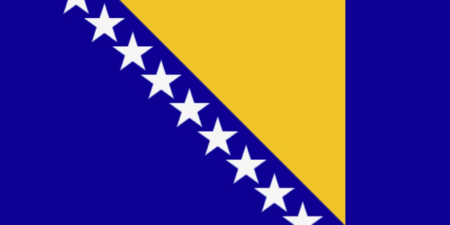Wed., 6/6/18 - Dubrovnik to Bosnia Herzegovina
This morning we departed Dubrovnik over the beautiful cable-stayed bridge, built in 2002, heading north along the Dalmatian Coast. The inhabitants of this area were Iberian shepherds called Dahlmen - Dahl means sheep. Their Dalmatian dogs were trained to attack Turkish horses.
Port sign
Dubrovnik's new cable-stayed bridge
Along the Dalmatian Coast
Along the Dalmatian Coast
We crossed into Bosnia-Herzegovina for 9 miles and then were back into Croatia. While in Bosnia-Herzegovina we saw many oyster and mussel beds and also trout farms. Bosnia-Herzegovina has two names because it is a country with two different geographical regions. We don’t know what this means yet.
This 9 miles of Bosnia-Herzegovina at the coast was to make a buffer between Dubrovnik, which was then a city-state, and the Venetian controlled northern part of what is now Croatia. At one point a one mile long bridge was started to be built that would avoid the borders with Bosnia-Herzegovina but construction was stopped due to political considerations.
We re-entered Croatia and drove along the rocky limestone mountains and the wide agricultural areas in the Neretva River Valley. The area grows a lot of mandarin oranges. There are also fig, olive, pomegranate, lemon, and walnut trees.
Oyster and mussel beds
A little piece of Bosnia-Herzegovina
A little piece of Bosnia-Herzegovina
Neretva River Valley
Neretva River Valley
We have entered Moslem territory - no alcohol or tobacco - and we are still in the month of Ramadan.
The population is “moderate” Sunni converted by the Turks in the 15th c. It was easier to live as a Moslem during Ottoman times than to pay higher taxes and give the first born son to be raised as an Ottoman soldier than to declare yourself as a Christian. Bosnian Moslems do not wear hijabs.
Mosques in Bosnia-Herzegovina with one minaret were built and paid for by local Moslems and those with two or more were paid for by the rich from Turkey or Saudi Arabia. There are three official languages in Bosnia-Herzegovina - Croatian, Bosnian, and Serbian - but all are really the same.
Flag of Bosnia-Herzegovina
We stopped for lunch in the medieval town of Mostar, Bosnia-Herzegovina. The town is “famous” (touristy) because of its historic 16th c. stone bridge over the Neretva River. The river divided the town into a Moslem section on the east and a Croatian Christian section on the west. The bridge was destroyed in the 90’s war and was rebuilt in 2004.
Lunch was a Turkish meal and afterwards we had time to walk across the bridge.
The Neretva River
Lunch
Mostar Bridge
Mostar Bridge
Local merchant
Trechrous walkway over the bridge
Museum of the Old Bridge
Neretva River
Lunch restaurant in the foreground
Shell of a building - from the 90’s war
Bullet holes in the walls from the 90’s war
Mostar Bridge
Lunch restaurant in the foreground
Walkway over the bridge
He also plays the guitar
St. Peter and Paul Catholic Church
St. Peter and Paul Catholic Church
St. Peter and Paul Catholic Church - interior being renovated
We continued north and east through the Canyon of the Neretva River and beautiful scenery to the town of Jablanica to use a western toilet. We had to buy a Coke for 1.50 Euros to use the toilet. This town is “famous” for a WWII battle where the partisans crossed the river on a wooden bridge and then destroyed all the bridges so the enemy couldn’t follow. This was the scene of the Battle of Neretva were Tito supposedly said “wounded ones should not be left behind.”
Very clever machine, like a portable car wash, for the tourist buses. It was a clever idea!
Rugged
Wonderful scenery
Collapsed wooden bridge over the Neretva River
Collapsed wooden bridge over the Neretva River
As we entered the city of Sarajevo, we saw how neighborhoods changed from single two-story houses to “Tito Brutalism” (ghetto-like high rises) to an Ottoman center city. Sarajevo hosted the 1984 Winter Olympics, the first organized in a Communist country. (Moscow hosted the 1980 Summer Olympics which the USA boycotted.) Many of the houses still show bullet holes or remain in total destruction. The Serbian army (army of Serbia and Montenegro) laid siege on Sarajevo for four years.
Trolly in Sarajevo
Familiar signs
View from our hotel
View from our hotel
We walked to dinner in the old town and had more Turkish influenced food. It was good, especially the cherry rakia that tasted like Cheracol.
| Return to Top | Return to Itinerary | Return to Trips page to view other trips | Return to Dreamcatcher Home Page |
.jpg)
.jpg)
.jpg)
.jpg)
.jpg)
.jpg)
.jpg)
.jpg)
.jpg)

.jpg)

.jpg)
.jpg)
.jpg)
.jpg)
.jpg)
.jpg)
.jpg)
.jpg)
.jpg)
.jpg)
.jpg)
.jpg)
.jpg)
.jpg)
.jpg)
.jpg)
.jpg)
.jpg)
.jpg)
.jpg)
.jpg)
.jpg)
.jpg)
.jpg)
.jpg)
.jpg)
.jpg)
.jpg)